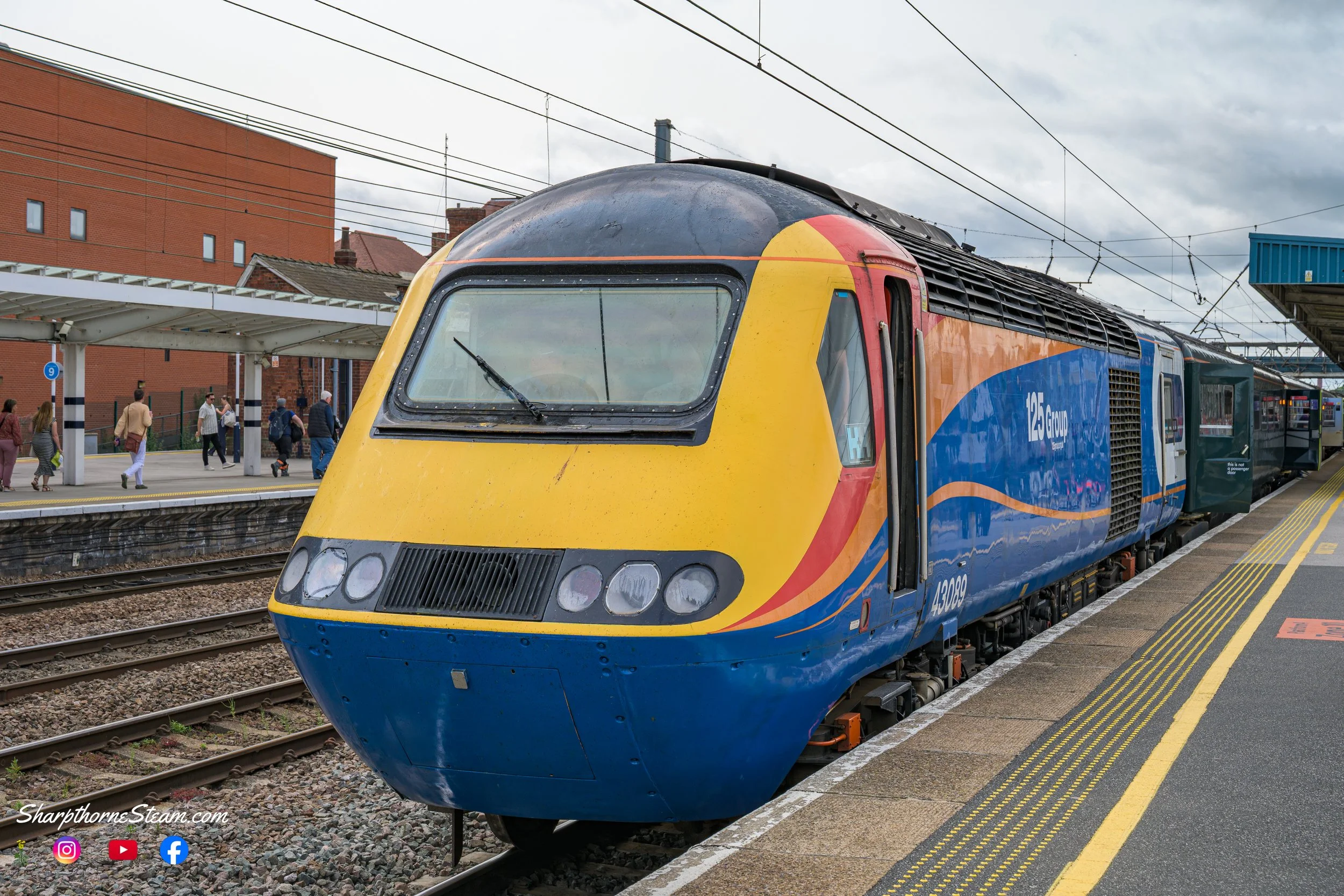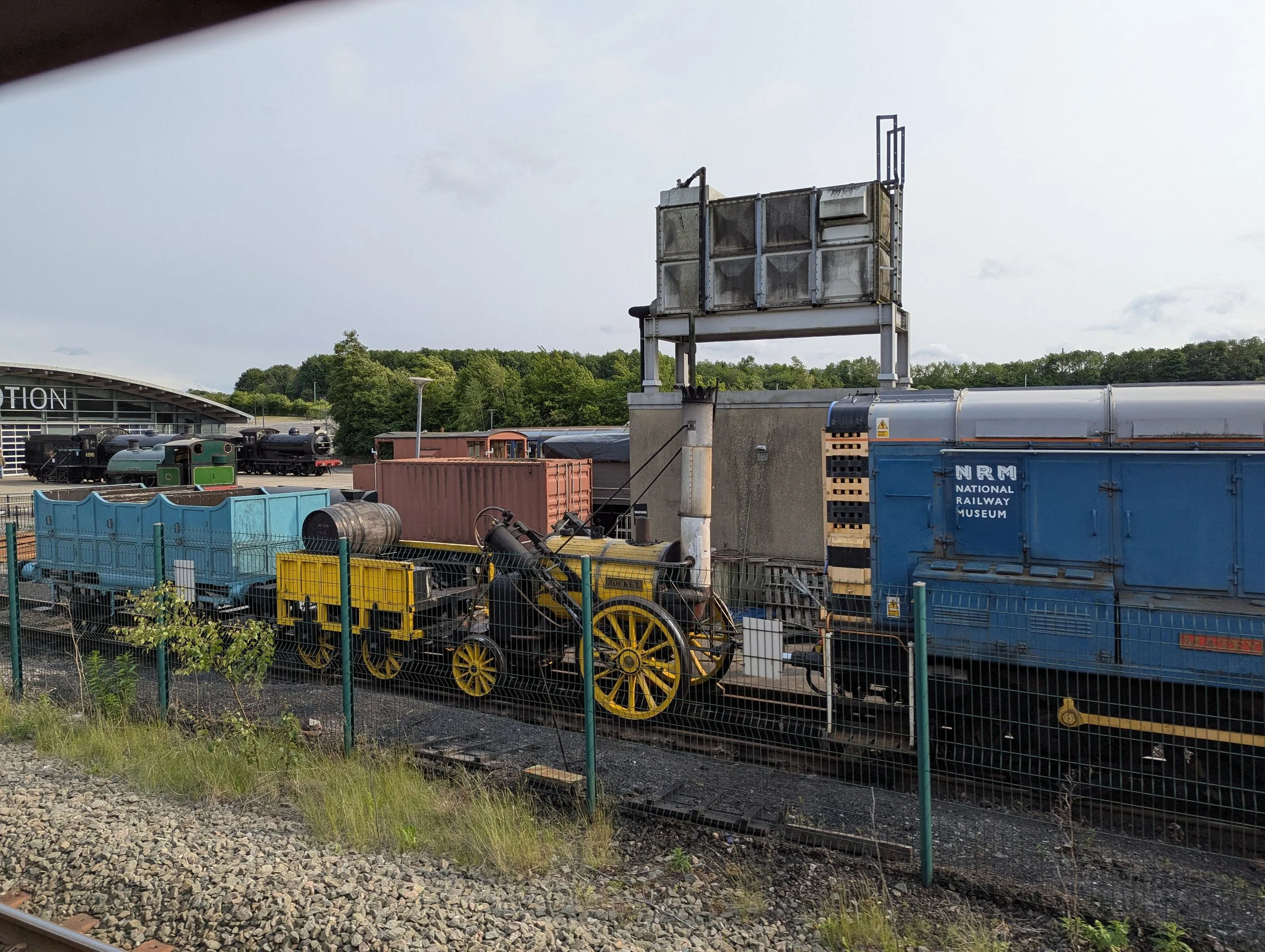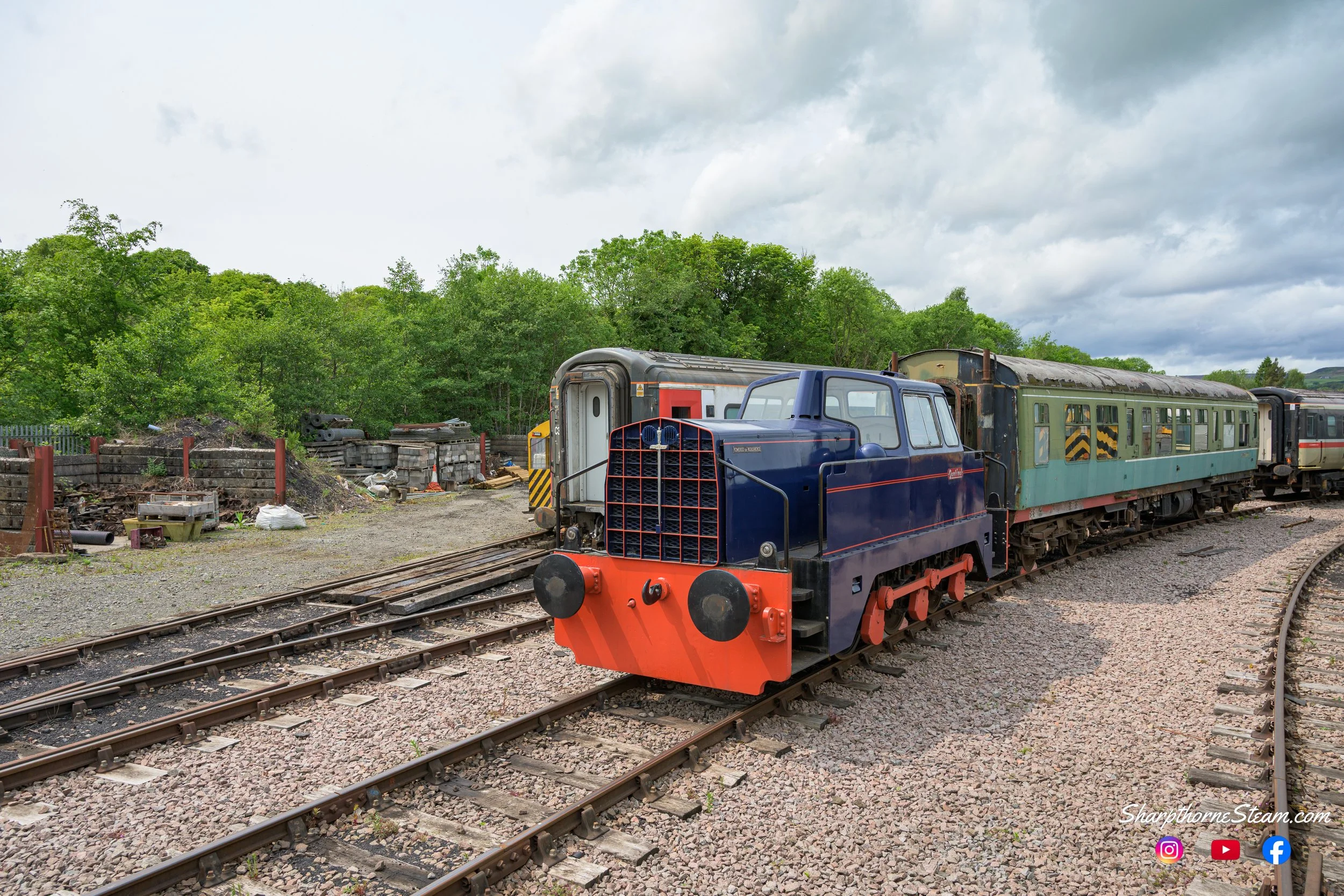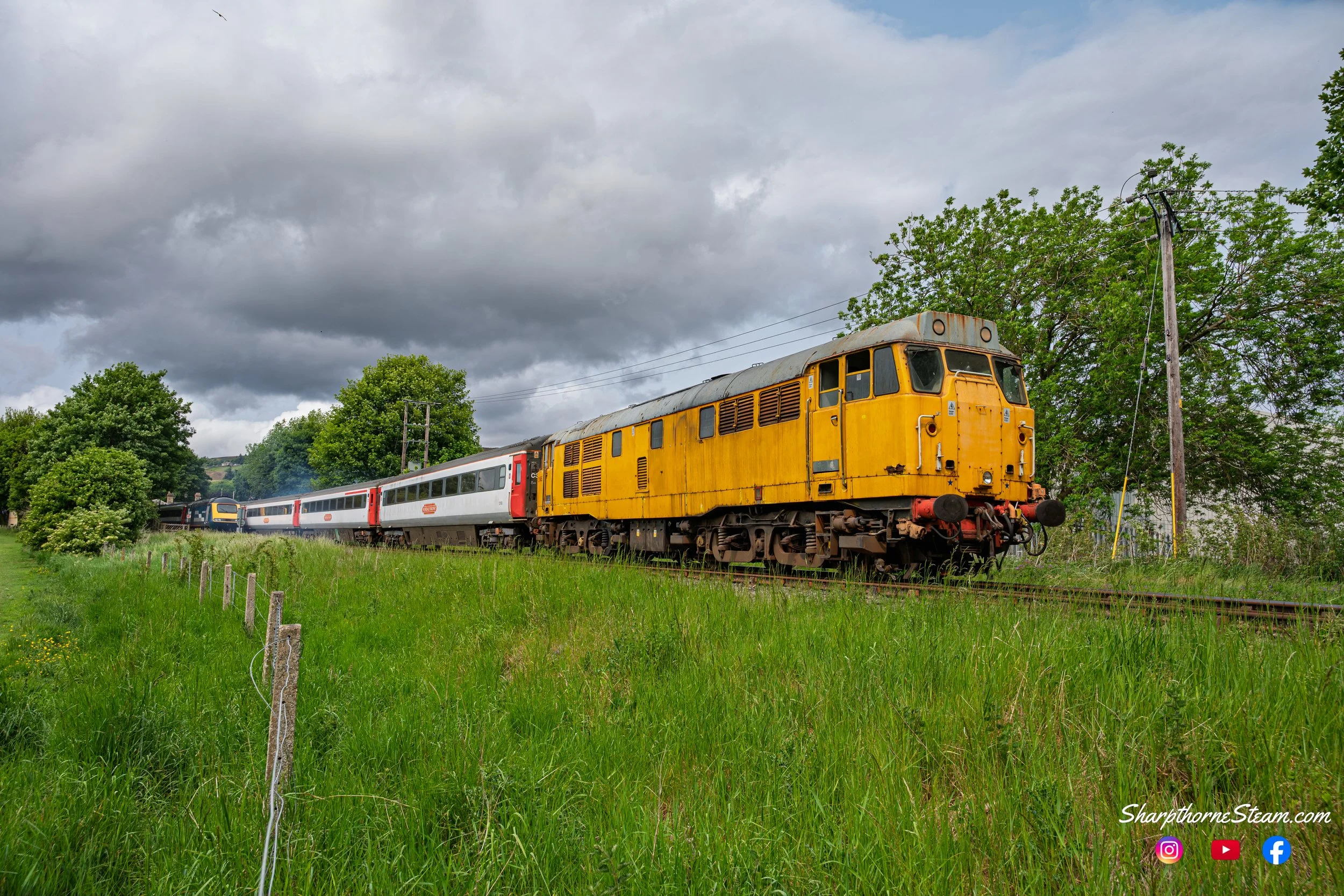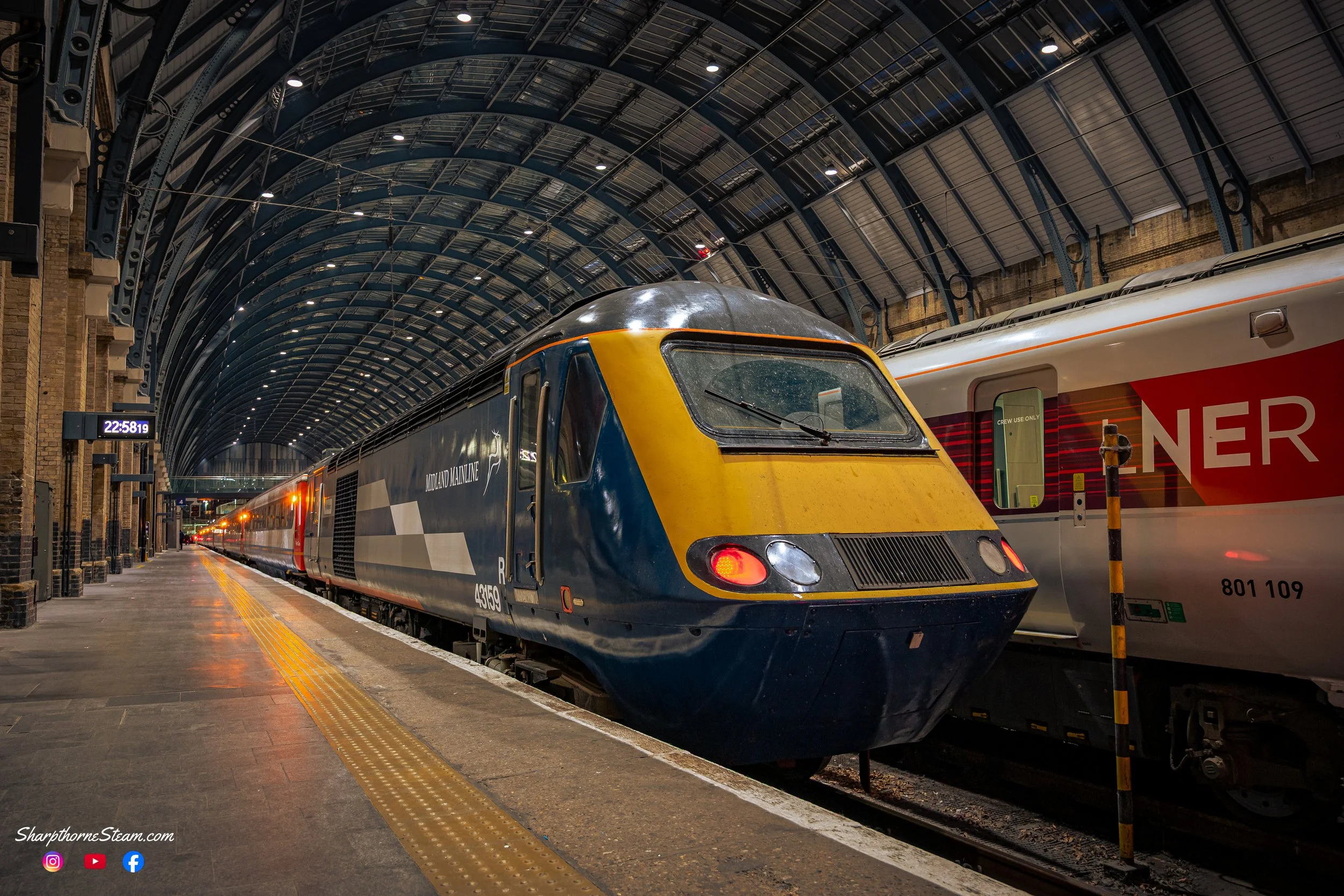125 to Stanhope
As I sit here pondering what to write in this blog with my lovely Tea 125 cup (tea really is better at 125mph) I think to myself how many icons of railway travel this country has produced in the 200 years of railways. Great Britain, a pioneer of railway travel back in 1825 with the Stockton & Darlington Railway and subsequent events has created many great locomotives, whether it be Rocket, Mallard, HST or the 225s. This railtour explored so much than just Weardale Railway or Locomotive at Shildon.
It explored the very history and identity of British Railways taking in many of the locations and iconic locomotives that made British Railways the envy of the world. We saw such sites as a replica of Stephson’s Rocket, Brush Works, King’s Cross station, Doncaster but also the end of British history by passing the recently closed Ratcliffe power station. Therefore, get your favourite brew and enjoy this whistle stop tour to Stanhope and back!
Train reporting number 1Z43 a Class 43 No.43089 stands at Doncaster awaiting her pathing to continue to York.
Camera settings: ISO: 100, Shutter: 1/320, Aperture: f8, Focal Length: 49mm
We arrived in King’s Cross and on the many destinations boards stood “Charter Train” our set had arrived and a public HST was back at King’s Cross for the first time in many years. But before that I first had to have a picture of the Sir Nigel Gresley statue, a man that until last year I hadn’t really appreciated his impact on the British Railway world. With that, we moved onto the platform and to our great relief we saw two high speed veterans standing together, a Class 91 and a Class 43 together for the first time since 2019. As always it was time to bring the camera out and get some snaps starting with a look at the generations of high speed trains standing at Kings Cross.
The generations of High speed Trains, from left to right, far left a Class 43 HST 125 43809, left - Class 91 91106 a 225 and right two Class 800 “Azuma”
Camera settings: ISO: 280, Shutter: 1/250, Aperture: f8, Focal Length: 24mm
Settling into our comfy and plush MkIII seats, it really does make you realise how much nicer things were for travel back in the 1970/80s compared to modern travel. We departed King’s Cross one minute down, but by our next reporting point we had made up that time (nothing holds back a HST) I had been joined on this trip by a grizzled veteran of many a HST (The Phantom Basher, a contributor to the Sharpthorne Steam pages) run in post-BR days and a person who was shocked this was my first HST mainline experience.
Our outbound route would take us up the East Coast Mainline and onto Stanhope via Bishop Auckland West including some rare track at York where we would divert onto the freight lines to avoid the busy station. It is always a pleasure to do 125mph and the comfort and feeling of gliding on the rails is something that any train buff should experience. Arriving at our first stop Shildon, this is the site of the Locomotion museum which houses not only a replica of Rocket but also numerous locomotives including the LNWR G2, prototype Deltic and also the prototype HST power car but also temporarily the P3, Q6 and Lucie from the North Yorkshire Moors Railway. For a good number of us, it would now be off to the preserved Weardale Railway at Bishop Auckland West.
Rocket replica with carriage after providing runs on the exhibition line at the Locomotion museum
Phone picture
The Weardale railway is not a railway I would do outside of this railtour, mainly due to it being five hours away from me and also because it currently doesn’t operate any steam. We left Shildon and made our way over the Weardale connection to the mainline. Going from 125mph to 25mph feels pedestrian.
Travelling along the Weardale is one of the most picturesque routes in the country, most of the line you can see the River Wear running either alongside or at several points cross it. We arrived in Wolsingham where a few of us would travel onto Stanhope and the majority of us would wait for two Banana Class 31s diesel locomotives. This trek was an interesting one as it would take us into the loco yard at Wolsingham for a behind the scenes view. In the yard we had Pacers, 1st gen DMUs and also some Gronks (Class 08 diesel shunters)
View of Wolsingham yard with a Sentinel shunter in the yard and a selection of DMU and coaching stock.
Camera settings: ISO: 200, Shutter: 1/500, Aperture: f7.1, Focal Length: 26mm
With all the track bashers getting in their rare track move it was now time to leave the yard and head to Stanhope with the two very smoky Class 31s, clearly trying to become steam locomotives with the amount of clag they were omitting. It was nice to get two former Network Rail Class 31s as their distinctive livery and additional equipment definitely sets them apart from other Class 31s.
At Stanhope we were told not to rush the 31s wouldn’t be returning to Wolsingham for 15 minutes. Shortly after we heard a whistle and two 31s preparing to depart, a quick dash (more a run really) and we were in position for the first of the shots at Stanhope before beginning the return leg. Zoom on the map below will show you how far in one day the 125 Group’s HST travelled from Kings Cross in London. All in all over the course of Saturday 31 May, we travelled circa 588 miles and 15 chains, with the ECML outward journey and then a return that led us down the Midland Mainline and past the spiritual home of the HST Loughborough and past Brush works.
Class 31 Diesel, No31465 departs from Stanhope with her sister 31285 (out of shot) as they head back to Wolsingham after hauling the “Scotch Island” Depot to Stanhope special working.
Camera settings: ISO: 160, Shutter: 1/500, Aperture: f7.1, Focal Length: 24mm
With the 31s back to Wolsingham, the HST pulled out of platform 2 and back into platform 1 for the long journey south that promised many different locations, including Barrow Hill, Erewash Valley, East Midlands Parkway for Radcliffe Power Station and also the Brush Works where these HST power cars were made. With a departure time of 1525hrs from Stanhope and a timetabled arrival at Kings Cross of 2247hrs it was due to be an interesting journey home. One thing I always forget about when I am enjoying this hobby is how fast time flies, if you were on a 7.5hrs flight I would count every second, but the excellent countryside, fantastic company and our assortment of food meant that 7.5hrs flew by. Before long we were racing back down south after picking up the Locomotion day trippers.
For me this was an excellent time to dive into my new book and enjoy some new presents that my friend had bought me. The book 125: The Enduring Icon was a fantastic read and a large number of pictures that help a steam fan like myself understand the sheer number of liveries that the HSTs carried in service.
Class 43 43159 shunts out of Stanhope and then back into platform one as she prepares for the first part of her journey back south to King’s Cross
Camera settings: ISO: 200, Shutter: 1/400, Aperture: f8, Focal Length: 62mm
With the day giving way to evening we snaked our way back south, this time instead of our train reporting number being 1Z43 it was 1Z44. We passed through Darlington again, site of one of the first railways in the country the Stockton-Darlington Line, again through the freight loop at York. At Colton Junction we turned right to run down towards Kingsferry, Barrow Hill, Chesterfield and the Midland Mainline then to Melton Mowbray (no they didn’t hand out free pork pies) to go across to Peterborough. Peterborough was to be our first stop to drop passengers off and with that we retraced our steps back down the East Coast Mainline. There were further stops at St Neots, Stevenage, Potters Bar before arriving back at King’s Cross bang on time at 2247hrs.
Back on the stops at King’s Cross, Class 43 No. 43159 prepares for the trip to Wembley were she will be stabled after her just under 600 mile round trip to Stanhope.
Camera settings: ISO: 400, Shutter: 1/8, Aperture: f4, Focal Length: 24mm
Thank you to everyone for tuning into this weeks railway adventures. There will be a weekend break now before we hit a big gala for the channel when we head to the Spa Valley Railway for their celebration of the closing of the Cuckoo Line. Speak to you all in two weeks, look after yourselves and enjoy your train journeys.

